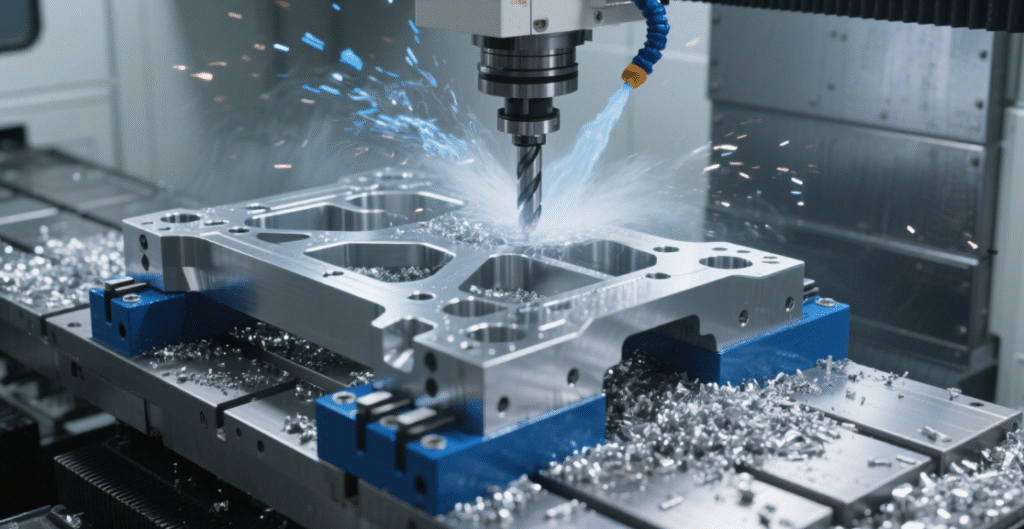High-speed cutting is an essential process in many industries, from manufacturing and aerospace to medical devices and automotive parts. The choice of material plays a crucial role in determining the success of cutting applications, and O1 tool steel has garnered significant attention for its performance in this area. In this blog, we’ll explore whether O1 tool steel is capable of handling high-speed cutting, its benefits, limitations, and the best applications where it excels.
Table of Contents
Introduction

O1 tool steel, also known as 1.2510 steel, is an oil-hardening, cold-work tool steel widely used in various industries. Known for its excellent toughness, wear resistance, and ease of heat treatment, O1 tool steel is often the material of choice for applications requiring precision and durability. But how well does it perform in high-speed cutting scenarios?
This blog will delve into how O1 tool steel handles high-speed cutting, the factors affecting its performance, and why it is a go-to material for industries requiring precise and long-lasting tools.
What Makes O1 Tool Steel Ideal for Cutting?
O1 tool steel stands out as a material of choice for many industrial cutting applications due to its remarkable balance of key properties such as toughness, wear resistance, and high hardness. These attributes make it particularly suitable for precision cutting tools, including blades, knives, and punches.
- Toughness: One of the standout qualities of O1 tool steel is its impressive toughness. This toughness allows the material to endure the stresses of high-speed cutting without experiencing cracking or breaking. When subjected to the impact and pressure of fast-paced cutting operations, O1 tool steel maintains its structural integrity. As a result, the likelihood of tool failure is significantly reduced, which is essential for industries where reliability is paramount.
- Wear Resistance: O1 tool steel’s high carbon content plays a crucial role in its outstanding wear resistance. The carbon content forms hard carbides within the material’s structure, which are critical for enhancing the steel’s resistance to abrasive wear. In high-speed cutting, where friction between the cutting tool and material generates heat and wear, O1 tool steel holds up impressively. Its ability to resist wear over extended periods ensures that cutting edges stay sharp longer, providing consistent performance throughout the lifespan of the tool.
- Ease of Heat Treatment: Another key factor that makes O1 tool steel ideal for cutting applications is its ease of heat treatment. O1 can be easily heat-treated to achieve the desired hardness, which is essential for maintaining cutting edge retention under high-speed conditions. The ability to fine-tune the hardness ensures that the steel performs optimally without compromising its toughness, allowing it to withstand extreme cutting conditions. Whether in high-impact cutting or high-precision applications, O1 tool steel’s heat-treatment flexibility makes it adaptable for various use cases.
Together, these properties make O1 tool steel a highly reliable material for cutting tasks that require precision, durability, and performance across multiple industries, from metalworking and automotive manufacturing to food processing.
How Does O1 Tool Steel Perform in High-Speed Cutting?

High-speed cutting demands a lot from cutting tools. The materials must withstand the high levels of heat and friction generated during the cutting process. These factors can degrade the performance of cutting tools if they are not made of the right materials. Fortunately, O1 tool steel can meet these demands, though it is not without its limitations.
Key Considerations for High-Speed Cutting with O1 Tool Steel:
- Heat Resistance: While O1 tool steel is highly durable, it may not perform as well in extremely high-temperature cutting environments compared to other tool steels such as H13 or D2. High-speed cutting generates significant heat, which can lead to thermal degradation, affecting the material’s hardness and edge retention. As such, for sustained high-speed cutting operations, it’s often necessary to incorporate a cooling mechanism to prevent overheating. Proper cooling ensures that the tool remains in optimal working condition, preventing premature failure or loss of edge quality.
- Cutting Tool Geometry: The design of the cutting tool plays a significant role in how well O1 tool steel handles high-speed cutting. The geometry of the cutting tool—such as rake angles, clearance angles, and cutting edge design—affects how effectively the tool can manage the stresses it faces during high-speed cutting. A well-designed tool with appropriate geometry helps in distributing the cutting forces evenly, preventing wear on one side of the tool, and ensuring a longer tool life. Therefore, the choice of tool geometry is a crucial factor in maximizing the performance of O1 tool steel in high-speed cutting.
- Speed Limits: Although O1 tool steel is well-suited for high-speed cutting, it is better suited for moderate speeds rather than ultra-high-speed operations. For extreme cutting speeds, materials with higher heat resistance and thermal stability, such as H13 tool steel, may be more appropriate. Nonetheless, O1’s combination of toughness and wear resistance allows it to excel in most high-speed cutting tasks where precision is required, without reaching the limits of ultra-high-speed cutting.
Despite these challenges, O1 tool steel remains a reliable material for many high-speed cutting applications due to its balanced properties and cost-effectiveness.
Applications of O1 Tool Steel in High-Speed Cutting
O1 tool steel is widely used for a range of cutting applications, where its combination of toughness and wear resistance is crucial. Below are some of the key industries and tools that benefit from using O1 steel in high-speed cutting:
1. Cutting Tools for Metalworking
Metalworking requires cutting tools that are not only durable but also maintain high levels of sharpness over time. O1 tool steel is frequently used for manufacturing industrial cutting tools like blades, knives, and shears. The steel’s excellent hardness ensures that the cutting edges stay sharp and perform well even under high-speed cutting conditions. This makes O1 tool steel ideal for industries requiring precision and consistency in cutting, such as tool manufacturing, automotive parts production, and heavy machinery assembly.
2. Aerospace and Automotive Industries
The aerospace and automotive industries require components that meet strict quality and performance standards. High-speed cutting plays a critical role in these industries, especially when machining complex metal alloys and components. O1 tool steel’s combination of high wear resistance and edge retention makes it an excellent choice for precision cutting tools used in the manufacturing of parts such as gears, shafts, and turbine blades. These parts must withstand high stress and temperatures, and O1 steel’s stability under such conditions makes it an ideal material.
3. Food Processing Industry
The food processing industry relies on cutting tools that can withstand continuous operation while maintaining sharpness. O1 tool steel excels in high-speed cutting applications in this sector, where it is used to manufacture knives, blades, and slicers. Whether it’s cutting meats, vegetables, or other food products, O1 tool steel provides the durability needed for sharp, clean cuts throughout the tool’s life. Its wear resistance is especially valuable in environments where frequent use and contact with hard food materials can quickly dull cutting edges.
4. Woodworking and Custom Tools
In woodworking, tools like router bits, planer blades, and saw blades experience constant stress and friction during use. O1 tool steel’s ability to maintain sharpness and resist wear ensures long-lasting performance even under high-speed cutting conditions. Additionally, custom tools, often crafted for specific needs, benefit from the precision and durability offered by O1 steel. Woodworkers and small-scale manufacturers, in particular, value O1 tool steel for its balance of machinability and toughness, making it a popular choice for custom-made cutting tools.
The Impact of Heat Treatment on O1 Tool Steel’s High-Speed Cutting Ability

The performance of O1 tool steel in high-speed cutting can be significantly influenced by the heat treatment process. Proper heat treatment enhances the steel’s hardness and wear resistance, making it more capable of withstanding the stresses of high-speed cutting.
Heat Treatment Process:
- Quenching: O1 tool steel is oil-hardened, meaning it is quenched in oil after heating. This process helps increase the hardness of the material.
- Tempering: After quenching, O1 steel is tempered to relieve internal stresses and improve toughness. Tempering allows the steel to maintain its high wear resistance without becoming too brittle.
The right heat treatment parameters help O1 tool steel retain its edge and cutting performance during high-speed cutting tasks.
Table: Comparison of O1 Tool Steel Properties
| Property | O1 Tool Steel | H13 Tool Steel | D2 Tool Steel |
|---|---|---|---|
| Hardness (HRC) | 58-64 | 50-55 | 55-62 |
| Tensile Strength | ≥153 MPa | ≥160 MPa | ≥180 MPa |
| Wear Resistance | High | Very High | High |
| Heat Resistance | Moderate | Excellent | Moderate |
| Toughness | Good | Excellent | Fair |
| Best Use | Cutting tools | Die casting | Precision dies |
As shown in the table, O1 tool steel performs well in wear resistance and hardness, making it a suitable choice for high-speed cutting, although for extreme conditions, other steels like H13 may be more appropriate.
Conclusion
O1 tool steel is a robust material that can handle high-speed cutting in many industries, offering a balance between toughness, wear resistance, and ease of heat treatment. While it performs exceptionally well in many high-speed cutting applications, its limitations at extremely high cutting speeds must be considered. Understanding the material’s strengths and optimizing its use through proper heat treatment and tool design can maximize its performance.
At Shandong Qilu Industrial Co., Ltd., we specialize in providing high-quality tool steels, including O1, H13, D2, and S7, to meet the diverse needs of our clients. Whether you need precision cutting tools, molds, or dies, our extensive range of tool steels can provide the durability and performance required for your applications.
FAQ
Q: Can O1 tool steel withstand extreme cutting temperatures?
A: O1 tool steel has good heat resistance but may struggle at extremely high cutting temperatures. Using cooling methods can help mitigate this issue.
Q: Is O1 tool steel suitable for high-speed machining?
A: Yes, O1 tool steel is suitable for high-speed machining, especially in applications where precision and wear resistance are crucial.
Q: How does O1 tool steel compare to other tool steels like H13 or D2 for high-speed cutting?
A: O1 tool steel offers excellent wear resistance and toughness for many cutting tasks. However, for extremely high temperatures or very high-speed cutting, H13 or D2 may perform better.
✨ Let’s Stay Connected!

If you enjoyed this blog on mechanical parts processing, don’t forget to join me on social media for more insights, updates, and community discussions.
📘 Facebook – Connect with me here
Let’s keep exploring, learning, and growing together. Thanks for reading, and see you in the next post! 🚀

